Behind the design of TEDxUbud's 2019 badges and bags
/The details of our 2019 TEDxUbud bag and badge design
Read More
The details of our 2019 TEDxUbud bag and badge design
Read MoreOur 8th edition was an incredible experience, possibly our strongest ever in terms of production and program. For an event that takes so much time and so many people to put together, often memories of those 12 hours can just seem like a blur of noise and light. Watching the photos come in from the phenomenal photographers can be a whole new experience and slightly surreal as we see things that as producers we didn’t get to witness in person (backstage doesn’t have great views), but only in our minds’s eye as we dreamed them up many months ago.
From over 1,300 official photos, it’s pretty hard to pick favorites. So we decided to ask each other what were our most loved images and memories of the night.

Prehistoric Body Theater performs. Photo by Shayna Pitch.

Julia blowing bubbles. Photo by Suki Zoe.

Making up the dinosaur dancers with natural clay pigment. Photo by Neyna Rahmadani.

Standing ovations always make our heart sing. Photo by Suki Zoe.

Azhar at work.

Under the X at night. Photo by Neyna Rahmadani.

With photographer Bang Dzoel. Photo by Suki Zoe.

Speaker Louise in deep concentration before going on stage. Photo by Neyna Rahmadani.

Joy and relief. Photo by Herry Santosa.

Powerful portrait of Jonny Miller by Bang Dzoel.

Food that moves! Cotton candy by Neyna Rahmadani.

The X from above. Photo by Neyna Rahmadani.

Our pop up name badge. Photo by Neyna Rahmadani.
We have the privilege of working with a group of amazing people every year. Thousands of people hours over months and months go into this one night. Every year we ask ourselves why we do this and every year the answer comes back the same: it’s because of the people we get to work with. From the technical crews, to the core team of volunteers, to sponsors, speakers, performers, on-the-day volunteers, creatives, it’s over 100 people who work on their small part of the magic.
Here are some of the less glamorous (but always satisfying) parts of the day before and day of TEDxUbud.

Wrestling the red dot. Photo by Suki Zoe.

X men at work. Photo by Neyna Rahmadani.

One of the most challenging days we’ve ever had because of the heat of the sun. Just incredibly hard on speakers and team. Photo by Suki Zoe.

Replacing a piece of the screen. Photo by Neyna Rahmadani.

Out go the cushions. Photo by Neyna Rahmadani

Waste management strategy in place. Photo by Herry Santosa.

A very focused jimmy jib operator. Photo by Suki Zoe.

The super team. Photo by Suki Zoe.

With Bang Dzoel, one of our official photographers.

Behind the stage. Photo by Bang Dzoel.


Photo by Neyna rahmadani.

Photo by Suki Zoe.
One of our favorite times of year is when the UWRF and all the amazing writers and speakers come to town. Every year we buy tickets for the team, close up shop and spend 4 days soaking everything in.
Everybody had a different panel they loved and brand new writers to google madly. We asked (some) of the team what their highlights were and they answered immediately.

Michellina
BRILLIANT SESSION, BEST TANDEM. A short feast for my whys!
One good tip from his festival club session with his wife on interfaith marriage:

Beautiful narrative too. Every line draws people in deeper.
Archana was raised to get the highest education her family could pay for and stay out of the kitchen and chores. So when she decided to quit her job and write a cooking book, judgment came from every corner.
The way that she balances her reasoning while respecting family values held so much poise and understanding.
Megan raised a compelling point along the line of:
Women authors who write around domestic space are often given lots of skepticism to voice and write their stories while men get their freedom and benefit of the doubt. (lots of classic lits by male authors have domestic space as the story background).

Ajeng
The Peripheral Vision session:
A critical session where the panelists from eastern Indonesia questioned what is peripheral vision and who measures the mainstream-peripheral perspective. As they believe that every experience has its own story, valid and primary to those who believe in humanity.
- Faisal Oddang, a writer who comes from Makassar, South Sulawesi.
- Theoresia Rumthe, a poet who had to move to Bandung after the civil war broke out in Ambon, Maluku.
- Setyawan Samad, a poet from Banda Neira, Maluku.
3 new book/writings I’d like to read after UWRF:
Now I am reading Claire G. Coleman’s writing about land and ancestors at ‘Meanjin’, a website containing essays, fiction, memoir, poetry, podcast and book reviews.
She has my respect for her views at the Speculative Fiction panel. One of the things she said was,
I definitely started to read Faisal Oddang’s writings. His background is Indonesian literature and proudly defines himself by speaking daily in the Bugis language. Saras Dewi also recommended him when she talked at the Precious Peatlands panel.
Pitchaya Sudbanthad’s book. I am interested in his view about the indelibility of memory (both individual and collective) and how to reconcile with what has happened; which also leads to a discussion around dreams and karma.

Mila
I wasn’t quite as organized in my note-taking…. So I wound up with a list of quotes and ideas from 4 days with no sources. Very lax of me…
These came from the amazing Lemn Sissay. A huge amount of energy to come out of one person- he had no problem making everyone squirm.
The joy of listening to Yottam Ottolenghi surprised me!

Reza Aslan was a revelation. I expected something else completely but loved the archaeological/historical lens he used to explain religion as we know it today.
Jono Lineen also had a similar style to Reza Aslan, but on the subject of walking. A fascinating flood of facts and ideas.
And finally Akala, who dropped this amazing fact among a 1,000 others.

Less than a month to go until TEDxUbud, gulp! Every year we feel a rush of gratitude for being able to put this event together and work with Bali's brightest and best. And while the challenges of wrangling these many people and moving parts may have us pulling our hair out right around this time, we love doing it. After all, there would be no Elami and Co without TEDx.
We'd like to give a big thanks to Ria and Skyler of Utama Spice, who have been so generous with their time and support for this event for so many years. We are very grateful to this amazing hometown brand that has taken their incredible message and brand around the world!

1// The 2019 TEDxUbud lineup is out!
We are very excited about this year's speakers and performers. Our theme of Movement has led us to curate talks about migration, emotional upheavals, changing the way we travel, dancing with dinosaurs, seismic activity, trade that feeds our hunger for the new, and how we can think more with our hands. We've been rehearsing with speakers for several weeks and they're better than ever.

2// A snippet that inspired us
3// Fill your bellies
To whet your appetites, we have some of Bali's best culinary creatives coming back to feed attendees this year; including Locavore, Pasti Enak, Moksa, Coffeenatics, Mia Chia, Gelato Secrets, Albens Cider, Stark Craft Beer, Krakakoa, Balipop, and Happy Kombucha! We're nearly sold out, book your tickets if you haven't done so yet.

4// Partner-in-art
We have the amazing Kanoko Takaya as our TEDxUbud artist for 2019! Kanoko is a Japanese artist who lives in Bali. Her work is filled with movement and popped into our minds when we started thinking of how we wanted this edition to look. Kanoko created portraits of each speaker and also a dreamy being filled with thoughts and ideas for our limited-edition volunteer t-shirts.

5// Our TEDxUbud space
So many of our attendees fell in love with Setia Darma’s incredible space when we held our first night event there in 2017, so we're very happy to be heading back there for our 8th edition. This museum opened in 2006 and its collection includes more than 1,300 masks and 5,700 puppets from around Indonesia and the world. It's a wonderful place to head to on the weekend, or the next time you have no idea what to do in Ubud with guests. Did we mention it's free?
Two of us (Ajeng and Mila- totally uncoordinated!) found ourselves at ArtJog 2019 a couple of weekends ago. Mila went with Summa Durie, one of our regular creative collaborators (she’s the Performance Curator for TEDxUbud) and also responsible for international programming at the amazing Rumah Sanur creative hub.

We spoiled ourselves with a mix of different art exhibitions and glimpses of the creative ecosystems in Jogja. ArtJog is an annual art festival with exhibition and contemporary art market components. It is always held in the middle of the year for a full month in Jogja.

Whirlwind of Time by Andrita Yuniza

by Agung ‘Agugn’ Prabowo

by Agnes Christina

Pest to Power by Natasha Tontey


At the same time, they also hold Jogja Art Weeks, an annual event where local galleries and art centers simultaneously hold events—everything from exhibitions, art and music performances, film screenings, discussions, and art workshops.
Jogja Art Weeks began as a non-profit initiative in Yogyakarta involving the art community, both artists and art enthusiasts, to be active in this new art movement that emphasizes on openness.
Jogja Art Weeks collects information and open doors for the community to access various art events in Yogyakarta and the surrounding area, as well as providing artists and multi-disciplinary art activitists in Indonesia with the opportunities to present and convey ideas, thinking, and art works to a wider audience.
Each year, Jogja Art Weeks publishes a booklet of publications on two whole months of art agenda, starting from visual art, art performances, music performances, workshops, discussions, art tours in Yogyakarta, Magelang, and Surakarta.


by Krack Studio

Pamor by Dedi Shofianto

at Langgeng Art Foundation

Jogja is well known for its art movements and activism, so anyone can benefit from just going there and finding events held by art collectives/spaces. This makes Jogja not only a great cultural city but also a dynamic and critical space for the creative industry.
Did you know that Jogja is famous for its nickname Kota Pelajar? It literally translates to “student city”. It is a destination and melting pot for a myriad of students from different cultural backgrounds in Indonesia and researchers from around the world—from art residency programs to student exchange programs. So many collaborations happen or have been initiated from meetings in Jogja. Definitely worth a visit!

For our first The Creative Refresh, Novi was one of our creative mentors. She creates textile art by fusing indigenous wisdom, artisanal craftsmanship, and sustainable innovation under the name of Cinta Bumi Artisans. Novi works with eco printing, bark cloth and plant dyes to create her wearable art. We sat down with Novi to ask her a few questions about how she got to Ubud and her creative process.

Tourism is my background. I was born, grew up, and worked in Jakarta as a tour program manager until 2009. Then I decided to move Bali since I really need something new in my life. At that time, I had an opportunity to work at Green School for a year and then the Odyssey Institute. My husband had a project to build a school for women in Poso, The Mosintuwu Institute, and we were both invited to Poso. The Mosintuwu Institute is a grassroots community organization whose members consist of Poso conflict survivors. At first, I thought I would come to a scary conflict area but it all changed when I arrived. Who knew that that would be the beginning of Cinta Bumi Artisans.
I was introduced to the Founder of the Mosintuwu Institute and asked to make a tourism program. So I stayed there 3 months to collect information with people there. One day, a man, who is now our artisans coordinator, took me to the rice fields where I could hear sound of hammering. It was in Lembah Bada, part of the National Park of Lore Lindu. I was so surprised seeing the women making ranta (barkcloth). The man said that I was so lucky because there were less than 10 people who could still do that.
They told me that they were making cloth for a ceremony and sometimes they make it for government tourism exhibitions too. But I’d never seen anything like this before, so I asked if I could buy a meter of textile to make something.
At that time, I travelled to Poso and Bali every 2 months. I usually stayed longer in Poso. So I made a bag fro ranta and even colored a part of it using natural dyes. When they saw the bag, they didn’t believe it was made from their ranta. So I proposed to work together with them - it was totally their decision to form the partnership. It’s their tradition, they do it from generation to generation, and I am just a women from a different background who fell in love with indigenous craftsmanship.
I encouraged myself to join the Pasar-Pasaran event in Ubud in 2016, officially launching the brand. For a year, we were focuses only on barkcloth until we faced a challenge. We had been working with 4 villages in Lembah Bada who always planted and harvested sustainably. Cinta Bumi Artisans always takes it in turn to source the barkcloth from different villages so that the trees have time to grow the bark back. It takes months to grow 40-50 meter per village per season. For a piece of 1x1 meter, the women work for 2 weeks.
However, the problem is most of the people don’t want to replant the trees. Especially the young generations. They tend to choose to work for the palm oil and mining companies because of the fast money they can get. I think that it would be really good for them replant, to take care of the trees, and maybe someday they can revive the barkcloth tradition and manage it for their economic and cultural sustainability. The paper mulberry tree (the barkcloth tree) was used to be endemic, even in Bali, but because of the clove plantations that massively established in Bali, they become rare. So the replanting is still the issue.

Cinta Bumi Artisans’ framework is based on everything made from the natural resources of Indonesia, on artisanal craftsmanship. For me, craft is everything you make with hands. I adore indigenous craftsmanship.
There are 4 types of plant sources that I use in the process: my dyeing garden, kitchen waste, roadside windfall, and waste from weddings. All are tropical leaves easily found here in Bali and Indonesia. Sometimes, the leaves surprise me with the medicinal benefits they have. It’s like making a healing cloth. So I wanted to develop and apply this to the eco-printing project. Now I am still exploring the possibility of using peace silk, which I found being produced in Jogja. The pea silk is made sustainably from the silk worm but no harm is inflicted in the process. Instead of boiling the cocoon right away, they wait for the silkworms to turn into butterflies first. Although I am not vegan, I always choose to be responsible with what I do and what I consume.
Cinta Bumi Artisans will soon launch Naluri Botanica, a collection using peace silk and barkcloth. Sometimes people call it cassava silk as the silkworms eat the cassava leaves. Naluri Botanica integrates the indigenous craftsmanship (barkcloth) with the contemporary art and natural dyeing (eco print). The products will vary, including bags, accessories, jewelry, etc. The difference with Cinta Bumi Artisans will be the medium. I am still exploring using the remnants of barkcloth and making it into jewelry.
Through the materials that I use for Naluri Botanica, I would like to encourage artists, designers, basically everyone, to know that Indonesia’s textile traditions include more than batik and ikat weaving.

One is the event that I really want to attend one day, the Folk Art Market in Santa Fe. It is a festival especially for indigenous cultural art around the world. I wish I could bring all the women from Poso there to exhibit their work with barkcloth.
The second one is TEDx. I used to attend the one in Jakarta and I really hope I can attend the one in Ubud. I love that the event gathers a lot of speakers from different background which I think is what we need as a person to grow- to listen and see other perspectives and experiences. From me personally, to not just meet with other textile artists, but also people from other fields to broaden my views.
The third one is the biennial Festival Panen Raya Nusantara (PARARA) in Jakarta. They present entrepreneurial products from various communities and indigenous peoples around Indonesia. These products are the result of long collaboration between entrepreneurs, communities and creative workers. The event aims to provide basic information about the importance of local products made by local communities to its visitors. It puts the spotlight on the value of a community’s struggle in producing products and safeguarding the natural environment where the products are produced.

We headed back to the amazing AB•BC art space to visit their latest exhibition: Balinese Masters: Aesthetic DNA Trajectories of Balinese Visual Art.
The Jakarta Post has an amazing wrap up of the exhibition and artists- definitely worth a read. As a team we fell in love with so many of the pieces. It was an incredible journey through Bali’s art history.


Wayan Sujana Suklu’s work grabbed our attention and we came back to it a few times throughout the morning.

Wayan Bendi’s 10 meter long painting in the Batuan style was incredible. So many sharp scenes, moments and commentary on Bali.

The pieces by Made Griyawan, especially this one of Gunung Agung erupting last year were such a pleasure to discover.

This pumice installation by I Made Djirna was also magic.







Looking forward to coming back to the space in October when Art Bali returns. We also have our fingers crossed for more representation for Bali and Indonesia’s female artists.
Join us for our eighth edition and a journey of storytelling, innovation, learning, change and more. We're returning to the beautiful Setia Darma House of Masks and Puppets with the theme of...

Everything in the world, and beyond, is constantly moving, in a state of ebb and flow, changing from one form to another.
Some of our movements are deliberate, as when we choose to travel, or dance. Other movements are beyond our control, or impossible to detect. Sometimes it’s not a pleasant sensation, as when we are forced into movement to escape something or have to push against the status quo to make a change.
When we say we are moved, we usually talk about emotion arising in our bodies, changing us in some way. When we talk about a movement, we talk about people working together to create social change or spread a new idea across the globe.
Movement is something we all share and participate in—a universal part of the human story as we cross the borders, lines and boundaries that structure our lives.
Ceramicist, mother, teacher – Sekarputri Sidhiawati wears many hats and owns each of them with admirable bravado. We were lucky enough to join forces with her for our fourth instalment of The Dinner Series – The Artists Dinner – hosted by Sekarputri and her husband Agung Prabowo at their Tegallalang home studio, Arta Derau.

Sekarputri’s charming ceramic pieces have long struck a chord with all of us at Elami & Co. Her exploration of soft organic shapes, feminine colours and strikingly relatable statements on life and society, worked in perfect synchronicity with the evening’s theme of fertility, femininity and Mother Earth. She created 139 individual pieces – little bird-shaped cups, oval platters and goblets, among them – from which Thy Neighbour presented their modern Thai eats and cocktails.


No two pieces from The Artists Dinner collection are the same. Each plate, cup and bowl is marked with its own motifs and is laden with character. She extracted clay from her own backyard (the rice-field our guests dined upon) to create every bespoke piece for the evening. And the best news? Her entire collection is available for sale.

We decided to hit the quirk button for this edition for an art-fuelled evening under the stars. We took over the rice fields behind Arta Derau ceramic studio.

Poorich Suvarnapadip from Thy Neighbour was behind the pans, turning out eight courses of his bright, progressive Thai fare using ingredients harvested from the surrounding paddies- we’re talking snails and rice field crabs, here.


Artist and Elppin designer Carina Hardy also came on board, exhibiting her world-first Back to the Breast eco-inflatable installation, previously featured at Thailand’s Wonderfuit Festival.

As dark fell, our projection mapping team brought the night alive with Agung Prabowo’s amazing art moving over the surface of the inflatables.

Thank you, again, to Agung and Sekarputri for hosting The Dinner Series 4.0. Stay tuned for our fifth installment happening later in the year.

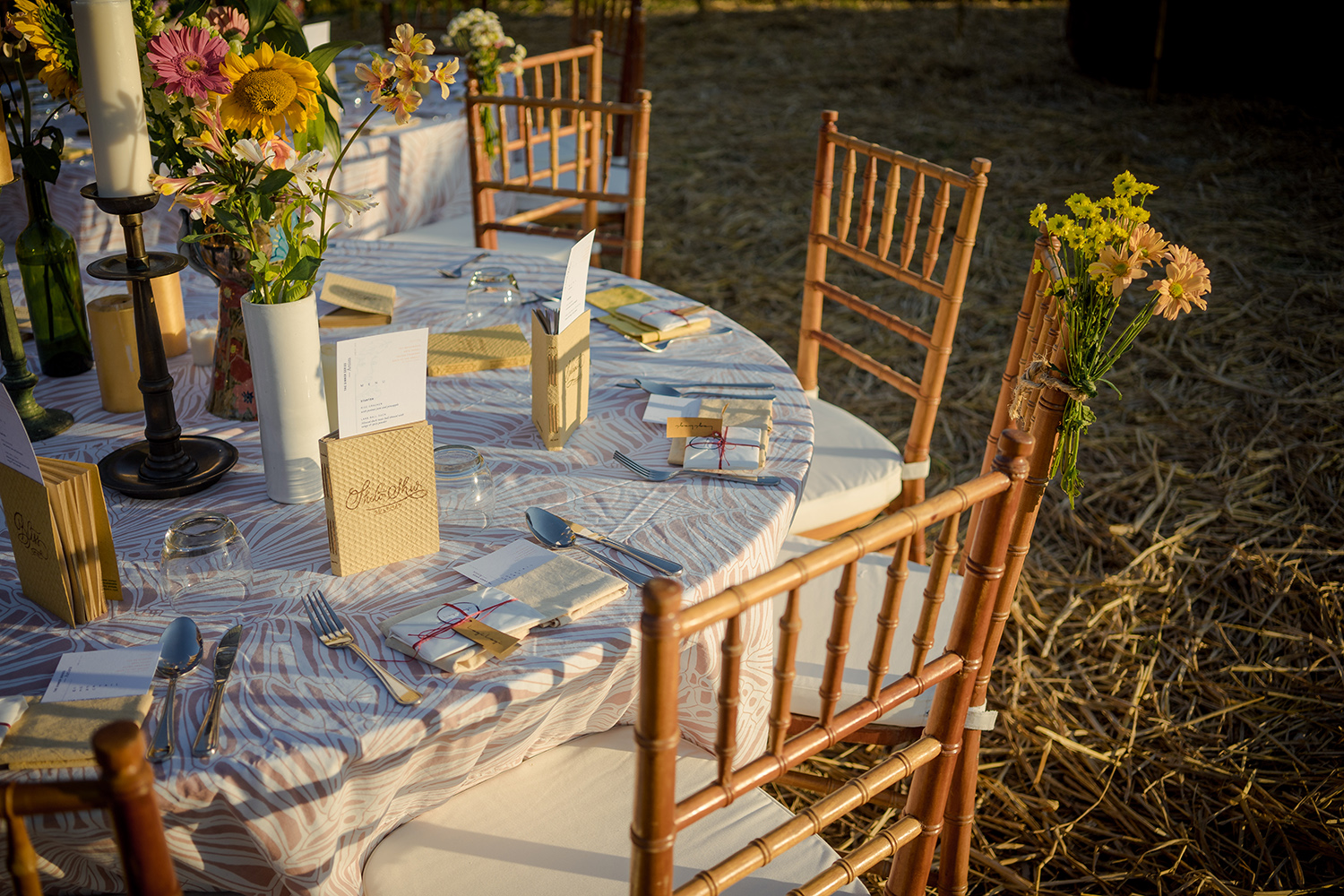


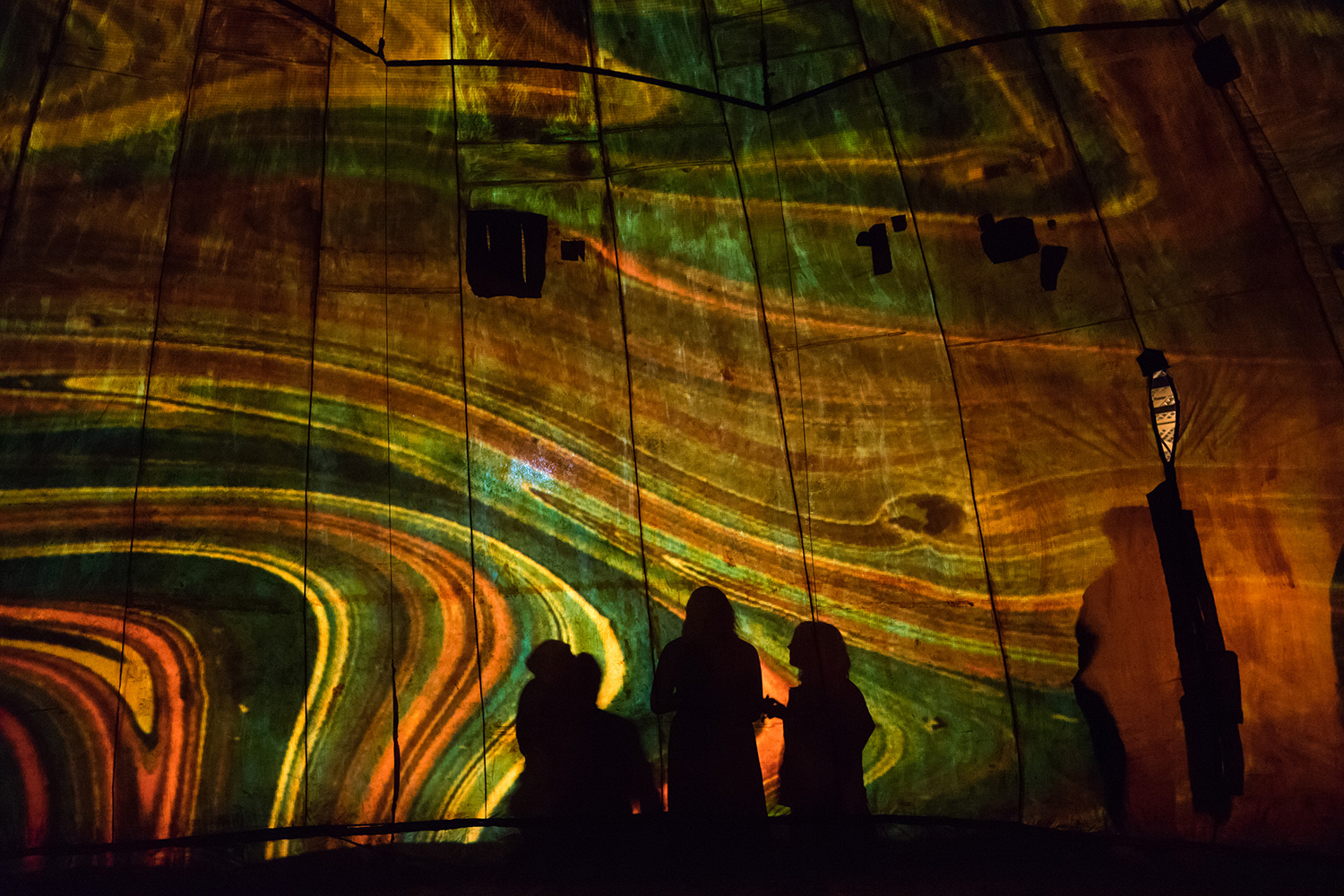



We have been working with Maya Kerthyasa to co-create The Dinner Series. We want more people to know her the way we do, so we sat down with her and asked a few questions of our favorite food writer.
I am half Balinese and half Australian. I grew up between Bali and Sydney and studied journalism. Since then, I’ve worked mainly as a food writer. I spent four-and-a-half years at Australian Gourmet Traveller Magazine and wrote a little bit about travel, but my strongest love is food. And that’s something that I’ve been interested in since I was born, really. I spent a lot of my childhood running around the back of house at Ibah, my parent’s hotel in Campuhan. And I think, through that, I developed a really strong love of hospitality.
I did my first restaurant review when I was nine years old with a dear friend of mine, Jane Adams, who has become one of my biggest mentors. I remember the day vividly, and from that moment on I have been fascinated by restaurants and food culture as a whole.
When I was working in magazines, I was lucky enough to eat and write about many different kinds of food. Now that I’ve had a child and am spending more time at home, I’ve made it my mission to focus on the food of Bali. It’s so layered, complex and full of cultural significance, but it just isn’t spoken about internationally. I’d like to change that, and so that’s where I am at the moment.

Maya and her grandmother in the kitchen
Well, I have a very healthy appetite. That helps. I’ve been fortunate enough to have eaten some really wonderful food not just in Bali, but around the world. Both of my parents are good cooks. So many of my fondest memories are connected to cooking and eating.
I’m also really lucky to still have both of my grandmothers, who cook in very different but equally wonderful ways. Food is an interesting way to explore not only the flavors of a place, but also its history and culture. And that’s why I love it. If you dig deep enough into most traditional cuisines, you’ll find they are laced with stories. When you dissect the ingredients, the way they’re prepared, you might see the history of a place, how it’s been influenced by other cultures, colonialism or immigrants. You can see how food is used as medicine, how it’s used to celebrate, even to mourn. So, for me food is such a strong vessel for discovery and connection.
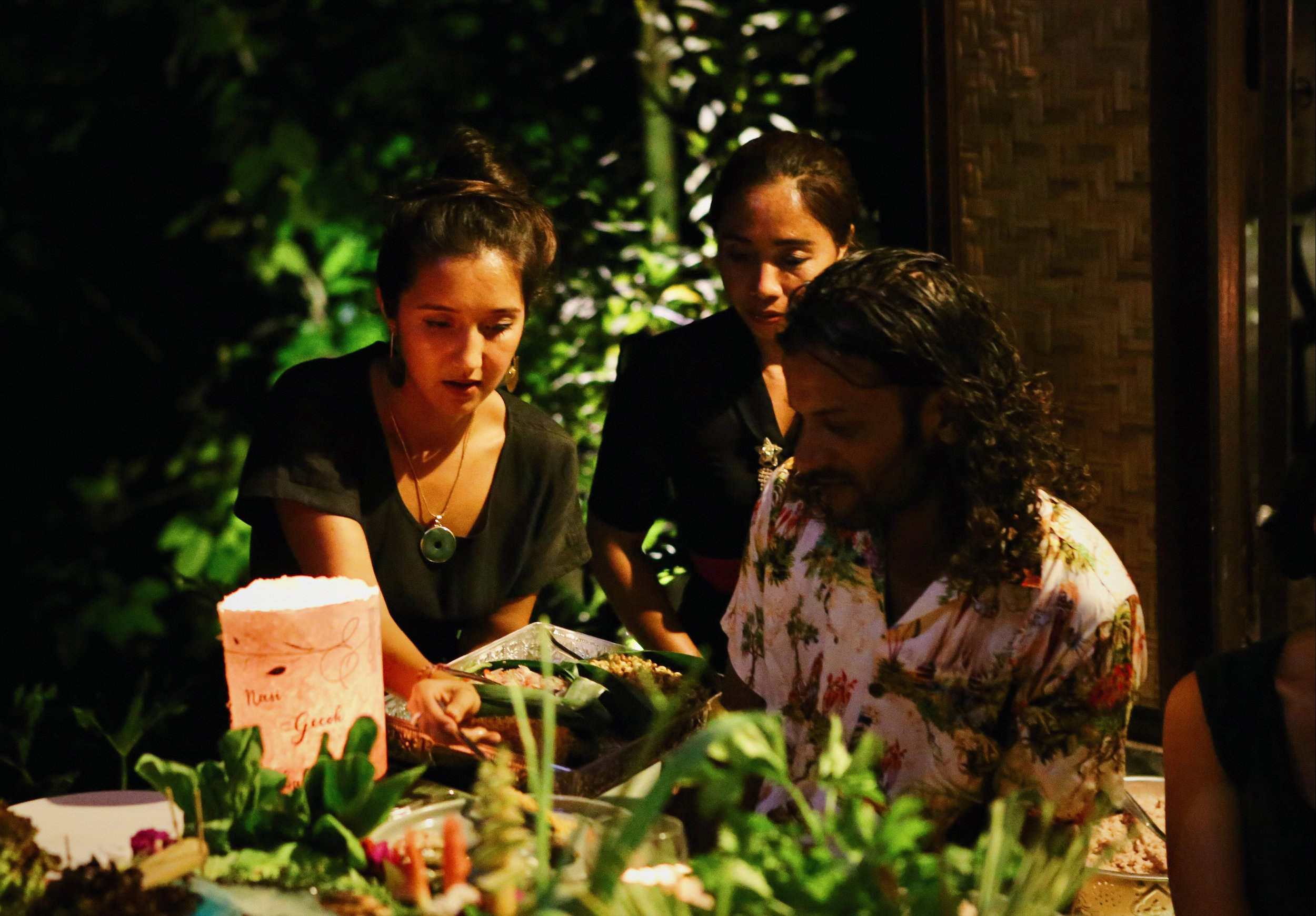
I have a lot of respect for Mila, Daniela and the Elami team, so I was really excited when we started talking about The Dinner Series. It’s started off as a conversation and then slowly it grew, and we did the first dinner at Green Village with Wayan Kresnayasa from Potato Head, which was such an amazing way to start.
Mila and I both saw an opportunity to create eclectic boutique events in Bali. Not your run-of-the-mill party or festival, or four-hands dinner – events that truly connect and inspire people in the creative field. I wanted to give some love to the people doing solid stuff in the culinary scene. And for Mila, there was a strong creative drive. You know, life in Bali changes so rapidly and these days we are all so divided by geography, traffic jams, and our own busy lives, that we don’t really get together as much as we used to. So, I think there’s a bit of nostalgia in there as well. To put it simply, we want to find people doing great things and celebrate them in the most interesting way possible.
The Dinner Series of course.
I am also in the process of recording my Balinese grandmother’s recipes in the hope of compiling them into a cookbook. I think there are so many layers to Balinese food that I haven’t yet explored, so I’m calling it a book about the food I grew up with. It’s taking a while, but it’s allowed me to spend some really precious time with my Niang who is in her 90s. And learning as much as I can from her, in more of a hands-on sense, as opposed to just writing and recording. It’s a very different approach for me, but it’s teaching me a lot about my culture, my family and who I am as a cook and a writer – having that ability to slow down and be truly conscious in the kitchen.

Every morning I try and do three pages of free writing. I’ve got a book especially for this, so I sit down with a cup of tea and my favourite pen and just write anything that comes to mind. Sometimes it makes no sense, some days it’s more of a diary entry, other times I’ll just write about the way the morning light is touching the kitchen bench that day. There are really no rules and it just gets my creative juices going.
To celebrate the launch of a new product line, Farmer to Fabric, Threads of Life opened their natural dye garden and studio to the public for an afternoon.

Guests were able to visit 6 stations demonstrating different parts of the natural dye process, take a mini-tour of the dye garden, purchase fabrics, learn about the workshops available, and talk to the team about any specific questions they had.
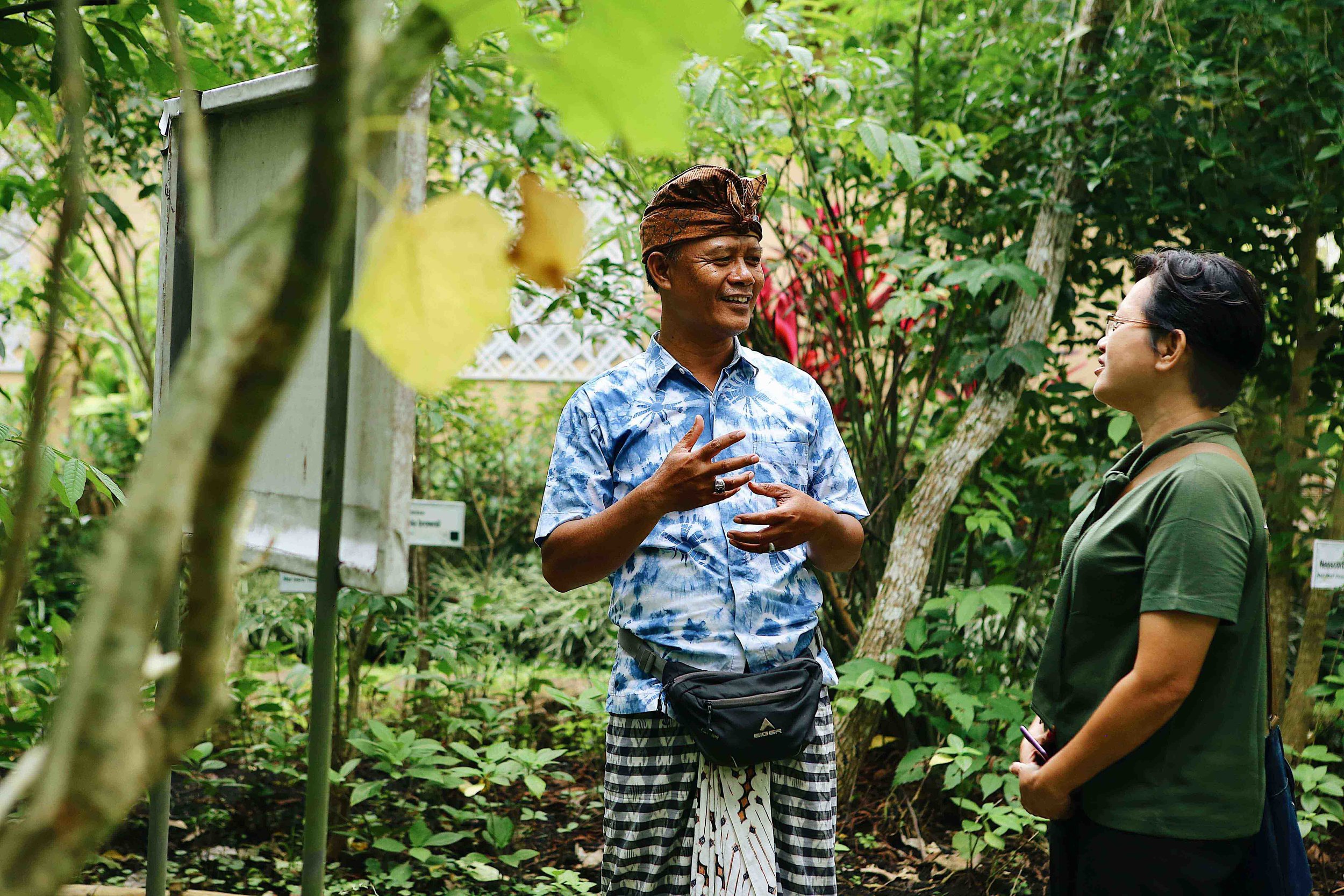

About Farmer to Fabric:
The Farmer to Fabric collection of hand-dyed natural-dyed fabrics brings the production values of our partner weaving communities to the work of our own dye studio in rural Bali: we use natural dyes by natural processes, avoiding synthetic additives; we work by hand, so that the mastery of our in-house dyers is evident in the look and feel of every unique piece; and we source our dyes directly from the farmers we have trained to grow and process the dyes.
This collection builds on natural dye practices with indigo, Ceriops-brown, mud-black, Morinda-red, and other traditional colours that we have studied since 1998 in collaboration with indigenous weavers across Indonesia. Through this research we have been able to discover where the transmission of knowledge between generations had broken down and facilitate revitalisation of traditions. With Farmer to Fabric we can now also support sustainable cultivation and use of the dye plants as a way of supporting the husbands of the weavers we work with.

Around 50 people joined the event. Many were long time supporters of Threads of Life but had never had the opportunity to visit the dye studio or learn more about the processes behind the beautiful colors of Indonesia’s textiles.
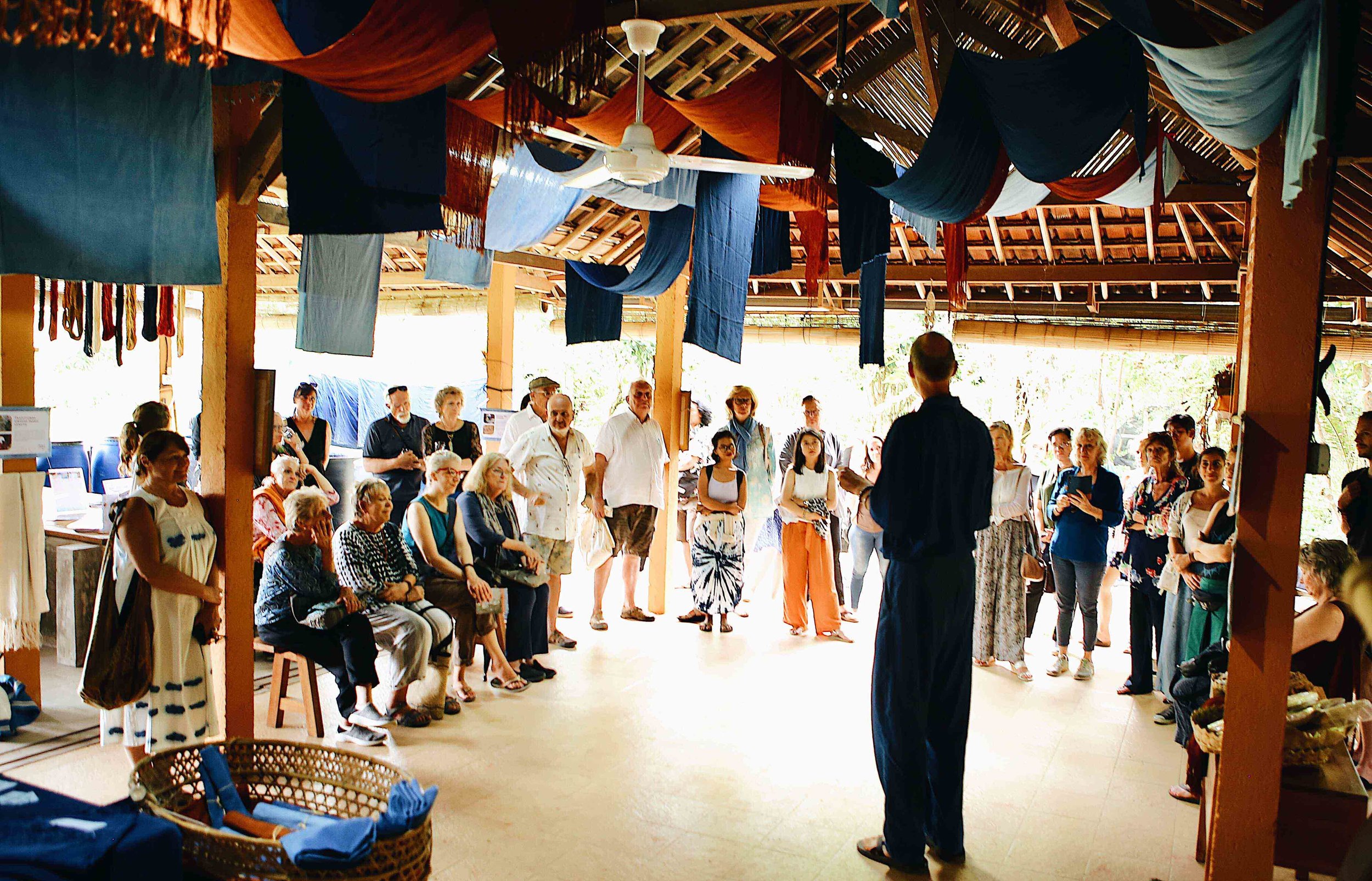


The beautiful cloth tag we designed for the Farmer to Fabric line. Screen-printed and hand-sewn to create pockets for the information about each piece.

The team from Earth Company has been working on a special project for the last few years. We’re happy to be part of the final piece of the puzzle by creating the brand identity for Mana Earthly Paradise and helping launch this eco accommodation located in Sayan, Bali. It’s set to open in June 2019. Follow their story on Instagram.
Nestled in Ubud’s heartland, Mana Ubud reimagines sustainable living for the eco-conscious traveller. Where the real luxury is in your connection to the land, the environment and the community.
Live in earth-bag bungalows constructed from all natural materials. Mana Ubud combines elements of traditional Balinese architecture with hints of minimalism and natural modernity. Experience low-impact living surrounded by the beauty of Bali.
Learn about innovative new eco-technologies that can reduce your footprint on the plant.
Leave your mark on the community. Your stay supports change-makers across the Asia Pacific.

For the palette we chose to use colors inspired by the warm tones of the mud walls and very organic shapes in line with the natural forms of the architecture and design. We looked to Japan, Bali and the Pacific for inspiration and references.
Much of the design of the space and structures was completed by the team at Hatiku Indonesia and their initial sketches inspired us in creating the initial feed for Instagram and social media posts.

One of our favorite things about Bali- the fast vanishing art of hand lettered signs offering various things. Sometimes offering services and products that are also rapidly becoming extinct (ahem fax). Bring back the beauty of handmade and imperfect over the neon lightboxes, we say!

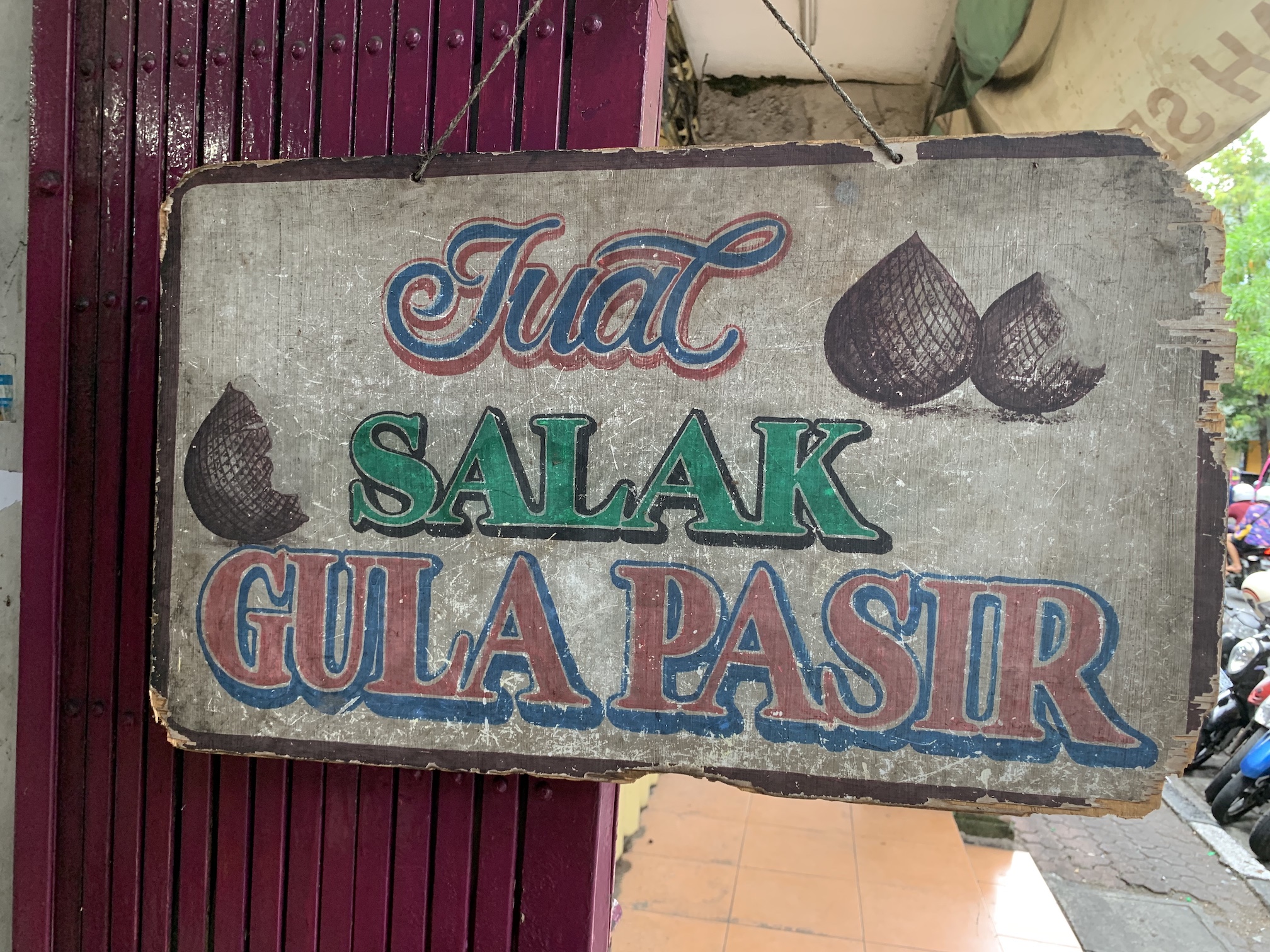





All photos by Cody Shwaiko.
Big or small, we’re an email away.
hello@elami.co
Event design, production, experiential marketing, brand storytelling.
© 2014-2025 PT Elami Daya Cipta